|
$347 round trip from Detroit to England was the going group rate in 1962 when Howard McEntee wrote this article soliciting
fellow travelers to attend the Internats. Expedia shows the same flight today would cost a little south of $1,100.
According to the BLS inflation calculator, $347 in 1962 is equivalent to $2,733 in 2014 money, so effectively
today's price is less than half of what it cost in 1962 - what a deal! There are many other items of interest in the column, including
R/C engine throttle modification, a Toledo Show brief, and a scheme for implementing tailwheel braking to achieve
3-point landings in tail draggers.
Everything Under Control: McEntee on R/C
World's most quoted columnist on radio control news brings you latest circuit data, club notes, contest developments.
|
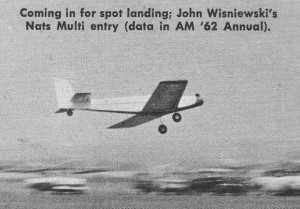
Coming In for spot landing; John Wisniewski's Nats Multi entry (data in AM '62 Annual).
|
Wanna go to the Internats? Remember a few offhand remarks we had here about comment Jack Josaitis made relative
to possibility of chartering an airliner to take a group to the R/C Internats in England this August? Jack has had
favorable reaction to the idea, enough so that he has looked into matter more carefully.
To charter a plane would require minimum of 86 persons, at approximately $300 for round trip from Detroit to England.
Price was right but Jack didn't feel it possible to sign up that many who would be willing to shell out about what
you could buy 10 channel rig for! But major airlines have announced new Group Travel Plan - and this puts a more interesting
light on the matter. Briefly, to get round trip price of $347 from Detroit to England, minimum Travel Group of 25
is required: all must go over together and return together. Above price is for 707 jet, Economy Class, and trip would
be about 7 hours non-stop. For $325 each, same deal, but via prop-jet-8 to 9 hours and probably not non-stop.
To qualify for Group Travel prices, all must have membership in an organization; AMA affiliation will cover this
requirement. Some U.S. modelers might wish to take planes over; a 100-lb. crate can be shipped for $64. Normal baggage
limit is 44-lb per passenger. Above prices are on BOAC planes - not some unknown non-sked. Tentative schedule has
been set for departure from Detroit Metro Airport on Saturday, Aug. 11; return from London Monday, Aug. 27. These
days picked because Group Travel Plan not good on Friday, Saturday or Sunday.
Meet is August 17 to 19; extra time is allowed for a little sight-seeing before and after meet. You'll need passport
and validated certificate of smallpox inoculation. Many other angles to this - drop Jack a word - he has all the details,
would love to have your company!
|
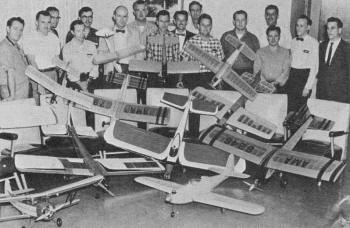
Martin Radio Control Modelers of Orlando, Florida.
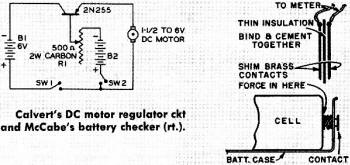
Calvert's DC motor regulator circuit and McCabe's battery checker (rt).
|
Martin R/C Modelers. This Orlando, Florida club with 22 active members, "has just started taking
shape" we hear from Robert Hulcher. As might be suspected, many of members work for the Martin outfit. The boys presently
have to drive 54 miles to flying field, hope to locate field closer by; with all the multi planes now in the group,
hard surface runways are becoming more necessary.
Walt Schoonard was proud owner of the P-39 in pic; Walt had "discovered" this scale type before it became so generally
popular. We say "was" the owner, since plane was totaled shortly after pic was taken, but Walt went right to work
on two more copies.
Motor Speed Regulator. Having need for electric motor that would run at constant speed, even though
supply voltage varied considerably, Fred Calvert evolved simple circuit shown. Speed of a DC motor is directly proportional
to supply voltage ... when voltage drops, speed also drops. The transistor acts as a variable series resistance, the
value of which is determined by bias voltage applied to base (battery B2). When voltage of B1 (which drives the motor)
falls, transistor base becomes more negative, reducing collector to emitter resistance and thus maintaining constant
voltage on motor.
A Mighty Midget motor was loaded to speed of 1500 rpm and B1 varied between 4 and 6 volts; speed change was less
than 1%. B2 is made from five mercury cells; any small units may be used as drain is very low. B1 depends upon current
drain of motor. 2N255 should be mounted on a heat sink of 20 ga. aluminum, 4" square.
Checking Battery Current. Simple way to test circuits supplied by batteries in holders such as
Acme, Hillcrest or Du-Bro, without removing cells from holder or having to break any leads is suggested by Garry McCabe.
He made a very thin "probe" from two pieces of shim brass with layer of paper between. This sandwich is cemented together,
leads soldered to the two metal outer pieces (do this soldering before you cement the assembly) and the probe tip
may be forced down between cell end and contact of battery case. Beveling ends of metal strips with a fine file will
make insertion easier.
|
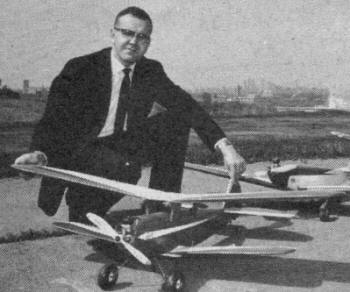
Ray Bergeson and bipe.
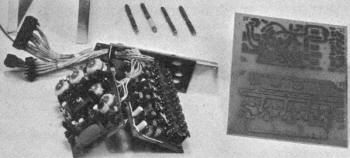
Bergeson's feedback proportional receiver based on the Doig Ulti-Multi.
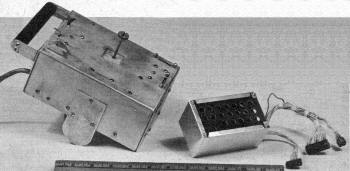
Proportional control box and receiver.
|
Doig Multi System. Ray Bergeson sends pic of himself with what appears to be original bipe design.
He has flown a number of planes, with controls ranging from simple escapement to triple proportional. Latter is the
Doig system, and close-ups show details of control box and receiver.
Box provides elevator and ailerons on the large stick, rudder on the large bar near top of case, and M. C. on small
bar. Originally a transfer switch was fitted, allowing shift of rudder to a rotary motion of the main stick, but this
was found too difficult to handle. Thumb wheels near lower (right) edge of box are for trim adjustment. Receiver is
a two layer job on P.C. boards; left portion in photo carries detector, amplifier, limiter and discriminator circuits
while right section has servo amplifiers. Relays have been used to allow full battery voltage to the servos without
need for expensive power transistors. Standard Bonner Duramites are employed, fitted with internal feed back pots.
Ray says he started with a two channel Doig system shortly after we had info in this mag, has progressed through
three versions up to that shown. He has racked up some 40 flight hours with these systems in an Astra-Hog and an Orion,
appears enthusiastic over results.
Old - Still Useful. We refer to idea given us some time ago by Major Chuck Walters and shown here.
It was devised when Chuck was trying to obtain real 3-point landings similar to those achieved by Walt Good and other
proportional fliers in the area. Chuck had a new Astra-Hog, found 3-pointers tough because the wing appeared to blank
out tail surfaces when nose was raised for such landings. Since plane trimmed out nicely in the air no added up elevator
was wanted for normal flight.
|
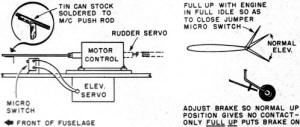
Major Walters' approach to 3-point landings.
|
Problem solved by arranging Micro-switch so it would be operated in full low speed position of M.C. servo. The switch
closes contacts indicated in Bonner servo instructions for obtaining additional servo throw. Brake is applied to tail
wheel in full up, is adjusted so that normal up does not give any braking action. For taxiing in windy weather, a
tap of high sped is given to get M. C. servo out of the full low speed position; this allows flier to hold normal
up elevator, and to steer plane on ground with rudder and tail wheel. In full up, brake locks latter so tight that
rudder will not turn. Same idea is used for spins, since normal up is sufficient, and you need full rudder action
to enter and hold spin.
Bleeding Throttles. Not as gory as it sounds, but a real necessity to get good low speed operation
of model glow engines. Most throttles such as the K&B give a rich fuel mixture when turned to low speed position,
and upper lip is usually "nicked" to allow more air to pass, so resultant mixture at full low speed is leaner. Some
throttles now come with adjustable bleed, but K&B does not, and here are three tricks for getting in the necessary
extra air.
|
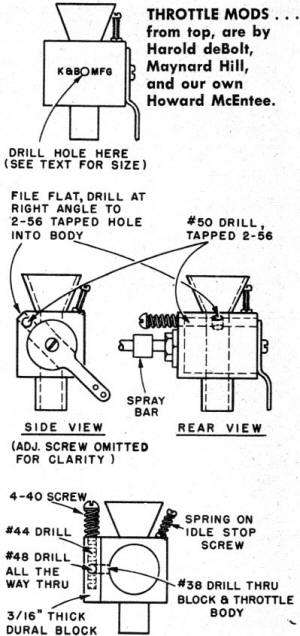
Throttle modifications.
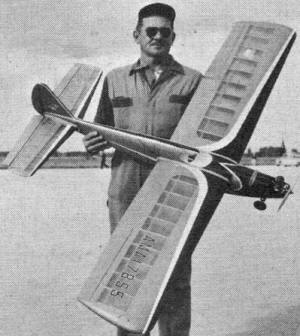
Big in radio at King Orange meet was Al Pinson, Atlanta, Georgia, with Multi event winner Pegasus, K&B
45, Bramco 10.
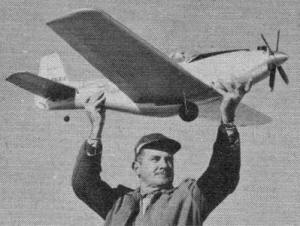
With 2nd in Scale with Sterling Mustang, K&B 45.
|
Top sketch is non-adjustable deal, has been used by Harold deBolt with good results. As applied to Supertigre .35
engine, with 11-6 Power Prop and K&B 100 fuel, also K&B R/C plug, only mod to throttle is to bore hole at
point shown. For his own uses, Dee has settled upon #55 drill as about perfect, but suggests starting with smaller
size, then enlarging till engine can be brought from low to high throttle without puffing out large Volume of smoke.
The hole is open only when rotor is below about 3/4 of the way to full low speed.
Using same throttle, Maynard Hill came up with scheme in middle sketches. This allows full adjustment of idle bleed.
With care, Maynard found he could drill and tap a 2-56 hole across one of the "corners" of the body, from edge to
edge. This takes the adjustment screw. A #50 drill was used for the tapped hole and hole down into throttle body is
#48. Spring holds idle bleed adjustment screw at desired position. The throttle should be one that does not have notched
upper lip on rotor - or you can use this type (they come this way on the Torp 45) and notch opposite lower lip to
match. The hole sizes given are large enough to allow ample bleed air for a K&B 45.
Our own efforts combined the two ideas. Mainly because we first tried the deBolt scheme and kept enlarging the
hole till it was definitely too large! Some sort of plug was needed to close the hole down, so a scrap of hard aluminum
was cut to fit the throttle body face, and the adjustment screw hole drilled in this. Screw was turned as shown -
handier with a side mounted engine as in KD3. Again the K&B basic throttle was used; note that we also used a
spring to hold the adjustment of the idle stop screw - much handier than a lock nut. If it is found the #48 hole through
the block is too much, one end can be blocked off. Our experience with this variable bleed on a Supertigre .35 was
that you couldn't "tune up" the bleed screw like you do the high speed needle valve, though there is some variation
of engine speed as you turn the screw.
Best way to get the proper adjustment seemed to be to let engine run at idle for a few months then throw rapidly
to high speed. If the engine emitted a cloud of smoke and stuttered a moment before it picked up speed, the bleed
screw needed to be opened some more. But if the engine quit running when throttle was suddenly opened, bleed should
be closed a bit. It was not hard to get a good in-between adjustment - minimum lag on speed pickup, yet the engine
would speed up reliably every time. Those who use rimmable throttle can set for a lower idle speed, since by "tapping"
the throttle out of low speed toward high, the engine is not so apt to quit as when you suddenly jam the throttle
to fun open.
There is one more trick worth mentioning. We told deBolt of an idea that had been suggested in this Column a few
years ago by a reader who made small slot with a Zona saw in lower lip of throttle rotor, felt this gave better idle
operation in conjunction with the usual notch on upper lip. Harold tried it, said he was sure it did a better job
with his drilled idle bleed hole. Slot would be made on lower lip that is almost closed, when barrel is in idle position,
and Dee says it shouldn't be more than 1/32" deep. If you go too deep, rotor just has to close a bit more. The slot
makes it much easier to set the idle stop screw, too.
Toledo Midwinter Conference. Report on this comes from Tom Dion. Held at Sunningdale Country Club
despite severe snow-storm that tied up the entire midwest, there were over 900 in attendance. Actually, as Tom notes,
it may have been a good thing the weather wasn't good! If it had been clear they could have had as many as 1500 -
and probably some of them would have had to hang from the roof.
Things were going strong by 10 AM Saturday morning; there were 15 R/C manufacturers and dealers with booths, and
quite a few tables were allotted for the exhibit of R/C planes and equipment brought by the modelers. Two talks were
given Saturday afternoon; Tom covered Rudder and single channel multi-surface proportional control, Zel Ritchie discussed
feedback proportional. Talks were in separate building from the booths and exhibits. Also on Saturday afternoon there
were some flying exhibitions. Spot Landing contest had been scheduled - called off due to 10" of snow. Tom says the
entire rear of the Club building housing the exhibits is of glass, and overlooks the golf course where the flying
took place. Thus all who wanted to watch the flying could do so, seated in warm comfort!
One of highlights of this Toledo affair has come to be the Saturday night R/C auction. Tom says the boys were really
buying this year and very little of any value was left when it was over. Auction ran from 7 P.M. to 3 A.M.! By Sunday
morning the storm had passed and the modelers started piling in. Only talk scheduled for this day was by Ed Kazmirski,
who discussed the new rules.
Posted July 19, 2014
|




